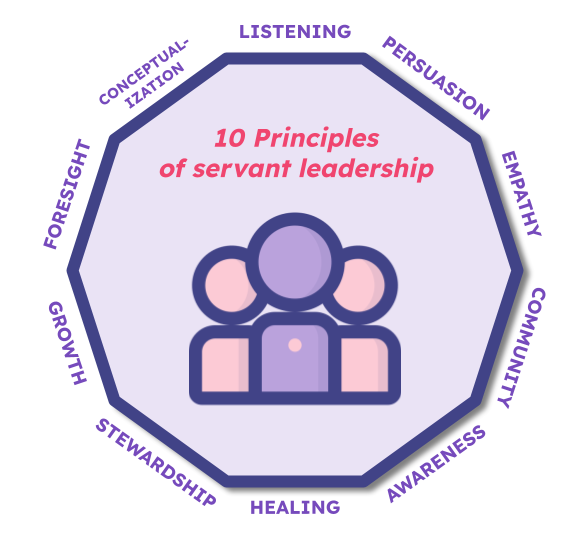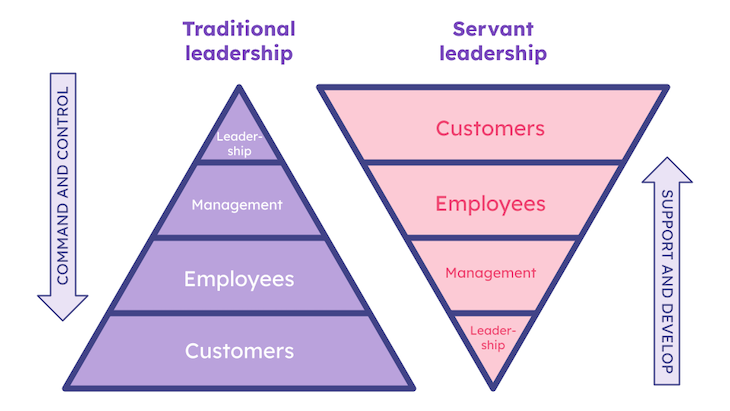Servant leadership is a powerful approach to management that has gained significant traction in recent years. This style of leadership focuses on empowering and supporting team members, fostering collaboration, and prioritizing the needs of others.

In this guide, we’ll explore the servant leadership style, including its benefits, principles, and common characteristics of a servant leader.
Servant leadership is a management philosophy where the primary goal of the leader is to serve and support their team members, enabling them to reach their full potential and achieve organizational success. By prioritizing the growth and well-being of their team, servant leaders create an environment that fosters trust, collaboration, and high performance.
The term servant leadership was first coined by Robert K. Greenleaf in 1970 in his landmark essay, “The Servant as Leader.” Since then, the concept has gained widespread popularity.
Servant leadership is based on the idea that leaders and managers should work toward the well-being of their team members by actively listening, empowering the team, and working toward team members’ development and growth. The key to developing a servant leadership style lies in creating an inclusive environment where everyone can thrive and excel without fear.
Servant leaders possess a unique set of characteristics that enable them to effectively support and empower their teams. These traits are essential for fostering collaboration, promoting personal growth, and ensuring the well-being of team members.
Some key characteristics of a servant leader include:
There are approximately 10 essential principles of servant leadership:

Let’s take a closer look at each principle:
Organizations that embrace servant leadership often experience a profound shift in their overall success and workplace culture. By prioritizing the needs of employees and fostering an environment of trust, empathy, and growth, servant leaders create a more engaged and productive workforce.
This approach not only benefits individual team members but also has far-reaching effects on the organization as a whole. If you’re considering transitioning from a traditional leadership style to servant leadership, here are some compelling reasons why this change can have a significant impact on your organization:
Servant leaders prioritize the well-being and development of their team members, which leads to increased employee engagement. When employees feel valued, supported, and empowered, they are more likely to be committed to their work and take ownership of their responsibilities.
This heightened level of engagement translates into higher productivity and better overall performance for the organization.
A key aspect of servant leadership is fostering open communication and collaboration within teams. By creating an inclusive environment where everyone’s ideas are valued and considered, servant leaders encourage teamwork and cooperation among employees.
This collaborative approach helps break down silos within the organization, leading to more efficient problem-solving and decision-making processes.
When employees feel genuinely cared for by their leaders, they are more likely to be satisfied with their jobs and remain loyal to the organization. Servant leaders prioritize employee well-being by actively listening to concerns, providing constructive feedback, and offering opportunities for personal growth.
As a result, organizations with servant leaders often experience lower turnover rates, saving time and resources on recruitment and training.
Servant leadership contributes to building a strong company culture rooted in trust, empathy, and shared values. By modeling these behaviors themselves, servant leaders set the tone for the entire organization.
A positive company culture not only attracts top talent but also helps retain existing employees who feel connected to the organization’s mission and values.
By empowering employees to take risks, learn from mistakes, and share their ideas openly, servant leaders create an environment where innovation can thrive. This culture of continuous learning and improvement helps organizations stay ahead of the competition and achieve long-term success.
The Employee Net Promoter Score (eNPS) is a metric used to measure employee loyalty and satisfaction. Organizations with servant leaders often see an improvement in their eNPS as employees feel more engaged, valued, and committed to the company’s success.
A higher eNPS indicates a more positive work environment, which can contribute to better overall performance.
Servant leadership’s focus on empathy, active listening, and collaboration extends beyond internal teams to include interactions with customers. By fostering a customer-centric mindset within the organization, servant leaders ensure that employees prioritize customer needs and deliver exceptional service. This approach leads to increased customer satisfaction, loyalty, and ultimately, business growth.
The fundamental difference between servant leadership and traditional leadership lies in their core values.
Servant leaders prioritize the needs of their team members and customers, creating an environment that fosters personal growth, collaboration, and customer satisfaction. On the other hand, traditional leaders focus primarily on achieving organizational goals through a top-down approach, emphasizing efficiency and productivity.
In servant leadership, the emphasis is placed on leadership supporting management, employees, and ultimately customers. Conversely, traditional leadership prioritizes customers first, followed by employees and management, with leadership at the apex of the hierarchy:

The table below highlights the key differences between servant leadership vs. traditional leadership:
| Aspect | Servant leader | Traditional leader |
|---|---|---|
| Communication | Emphasizes active listening, transparent communication, and a supportive environment | Wields power through directive communication systems and top-down approaches |
| Power and authority | Embraces shared power and encourages a more democratic approach where followers are involved in decision-making processes | Seeks compliance with direction and prefers formal authority to control subordinates |
| Focus | Focuses on creating a positive work environment, building strong relationships, and fostering personal development and growth for team members | Concentrates on meeting targets efficiently and productively, acting more as task givers to achieve organizational goals |
| Relationship development | Emphasizes empowering and inspiring followers, valuing transformational relationships without hesitation | Prefers transactional relationships and maintains distance from followers |
Some exceptional product leaders have embraced the servant leadership style to great success. Among the most notable servant leaders are:
For one notable example, Jeff Bezos at Amazon demonstrated several servant leadership characteristics:
Customer obsession
Jeff Bezos introduced the concept of working backward with the customer. This approach focuses on understanding customer problems and building customer-centric products to drive company growth. Bezos helped Amazon become the most customer-centric organization through customer-guided product development.
Visionary
Amazon’s famous 16 leadership principles are based on customer obsession and ownership, fostering the concept of acting as a visionary leader without relying on role names or designations. The foundation of these principles depends on not losing focus from customers and not sacrificing long-term vision for short-term results.
Bezos asserted that patience and commitment to customer experience are necessary for innovation, customer satisfaction, and building best-of-breed products (e.g., Kindle, Prime, amazon.com, hyperpersonalization growth).
Trust in your team (the “two-pizza” approach)
Bezos proposed the concept of “two-pizza teams” to empower product teams. He endorsed small, independent teams of seven to eight people to hold accountability for end-to-end product releases.
This concept brought autonomy, innovation, experimentation, and customer focus. Because each team member holds decision-making authority, they tend to feel more valued and thus more personally invested in the success of your product or business.
Similarly, Tony Hsieh at Zappos emphasized employee empowerment, customer focus, learning, and growth to foster Zappos’ culture.
Under Hsieh’s leadership, Zappos became renowned for its exceptional customer service and unique company culture. He implemented practices such as the “holacracy” management system, which decentralized authority and empowered employees to make decisions that aligned with the company’s core values.
Additionally, Hsieh prioritized employee happiness and well-being by offering extensive training programs, creating a fun work environment, and promoting open communication. This servant leadership approach resulted in high employee engagement, loyalty, and a strong commitment to delivering outstanding customer experiences.
Since taking the helm as CEO of General Motors (GM) in 2014, Mary Barra has made significant strides in transforming GM’s culture and operations by embracing servant leadership principles.
Under Barra’s leadership, GM has shifted its focus toward innovation, sustainability, and long-term growth. She has championed the development of electric vehicles and autonomous driving technology, positioning GM as a leader in the future of transportation.
Barra’s servant leadership style is evident in her approach to communication and collaboration. She prioritizes transparency and open dialogue within the organization, breaking down barriers between management and employees. By fostering an environment where everyone’s voice is heard and valued, she encourages a sense of ownership and accountability among team members.
One notable example of Barra’s commitment to servant leadership is her response to the ignition switch recall crisis that occurred shortly after she became CEO. Instead of deflecting blame or hiding behind corporate jargon, Barra took responsibility for the issue, apologized publicly, and committed to making things right for affected customers. She also implemented changes within GM to improve safety protocols and ensure such issues would not occur again.
Furthermore, Barra emphasizes employee development and growth as part of her servant leadership approach. She invests in training programs and mentorship opportunities that empower employees to advance their careers within the company. This focus on personal growth helps create a more engaged workforce dedicated to achieving GM’s goals.
Barra’s servant leadership style has contributed significantly to General Motors’ success by fostering a culture of innovation, transparency, collaboration, and employee empowerment. Her approach serves as an inspiring example for other leaders seeking to make a positive impact on their organizations.
A manager’s role involves much more than controlling the team and directing it to work on specific tasks. Product culture is about influencing a team without control.
Product management is one of the best examples of servant leadership because PMs share knowledge, rely on data, collaborate quickly in decision-making processes, and remain humble and open to feedback — all of which align with the nine principles of servant leadership described above. Furthermore, product managers interact with various stakeholders and clients, requiring them to foster a culture of empathy, collaboration, and leading by example.
Here are some best practices and strategies for embracing the servant leadership style in your organization:
You should foster a learning environment by providing access to training opportunities and promoting continuous learning and growth.
Acknowledging and celebrating team members’ successes is key to motivating the product team to perform their best. Give credit where it’s due, publicly acknowledge contributions both big and small, and embrace a sense of appreciation within the team.
Be responsive to your team’s actions and behaviors and remain open to feedback from team members. This provides ample opportunity to identify areas for improvement and practice servant leadership.
Regularly reflecting on these tactics helps you earn the trust of others and stay curious about learning through experience.
Seasoned managers should foster a learning environment by coaching and mentoring others, helping the team, and inspiring other managers to develop the skills needed to achieve their goals.
For example, product leaders often contribute to driving product forums, knowledge-sharing networks, and learning workshops within the organization. As a result, they are recognized for building a culture of sharing, guidance, and empowering others.
Servant leadership fosters cross-functional relationship culture through open communication, empathy, understanding, and applying shared vision and goals.
For instance, by clearly emphasizing company vision and objectives, a good servant leader promotes alignment by putting themselves in the shoes of customers and considering other perspectives within the team. This approach breaks down silos and promotes collaboration.
Another example is celebrating cross-functional achievements and reinforcing the value of collaboration by giving credit to the team and others.
By promoting a culture of collaboration, empathy, teamwork, team development, and cross-functional relationships, servant leaders break down barriers and enable an environment where everyone works together toward measurable goals rather than dictating steps for execution to the product team.
As a result, servant leadership fosters innovation, high retention rates, improved performance, effective communication within teams as well as with cross-functional teams.
In today’s world where product-led growth is every company’s ambition, servant leadership fits this strategy perfectly. Embracing this leadership style can help organizations achieve greater success while creating a positive work environment that values employee well-being and development.
Featured image source: IconScout

LogRocket identifies friction points in the user experience so you can make informed decisions about product and design changes that must happen to hit your goals.
With LogRocket, you can understand the scope of the issues affecting your product and prioritize the changes that need to be made. LogRocket simplifies workflows by allowing Engineering, Product, UX, and Design teams to work from the same data as you, eliminating any confusion about what needs to be done.
Get your teams on the same page — try LogRocket today.

A practical framework for PMs to use AI in ideation without sacrificing judgment, strategy, or decision quality.

A practical five minute revenue estimation method to help product managers compare ideas, drop low impact features, and prioritize smarter.

A practical guide for PMs who want to stop being bottlenecks, delegate smarter, and lead teams effectively with a clear ownership framework.

Stop letting unreliable data block features. Treat data as inventory to track quality, ownership, and ship with confidence.